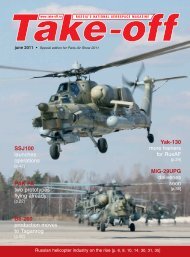Create successful ePaper yourself
Turn your PDF publications into a flip-book with our unique Google optimized e-Paper software.
cosmonautics | in brief<br />
Aspects of GLONASS development<br />
The development of the Russian<br />
global satellite navigation system<br />
dubbed GLONASS kicked <strong>off</strong> as<br />
many as two decades ago, but the<br />
‘steamroller’ of the 1990s almost<br />
ran it into the ground. Mere seven<br />
satellites of the constellation were<br />
active in orbit as of 2007 despite the<br />
measures taken by the government.<br />
Meanwhile, effective operation of<br />
the GLONASS is possible only in<br />
case the whole 24-satellite constellation<br />
is deployed.<br />
Given the importance of the issue,<br />
Russian President Vladimir Putin on<br />
17 May 2007 issued the decree on<br />
using the GLONASS global satellite<br />
navigation system in support<br />
of economic development of the<br />
Russian Federation, allowing access<br />
commercial users, including foreign<br />
ones, to navigation data.<br />
Under the decree, the Federal<br />
Space Agency (Roscosmos) was<br />
appointed coordinator of the efforts<br />
to maintain, develop and operate<br />
the GLONASS system in the interest<br />
of civil users. In addition, the<br />
government was tasked with determining<br />
the powers of the federal<br />
authorities in maintaining, developing<br />
and operating the constellation<br />
prior to 31 December 2007 and with<br />
adopting before late 2011 a relevant<br />
federal programme to be pursued<br />
during 2012–20.<br />
Attending the MAKS 2007 air<br />
show, President Putin visited the<br />
stand of RNIIKP, the core company<br />
of the Russian Corporation of<br />
Rocket-Space Device Engineering<br />
and Information Systems being<br />
established now. The President was<br />
briefed on the latest developments<br />
under the GLONASS programme,<br />
proving that the state’s interest in<br />
bringing the satnav system up to<br />
snuff is no lip service. Roscosmos<br />
chief Anatoly Perminov familiarised<br />
the President with a full-size<br />
mockup of the Reshetnev NPO PM’s<br />
advanced Glonass-K satellite and<br />
satnav user gear and brought him<br />
abreast of the status of the programme<br />
as a whole.<br />
According to NPO PM, new satellites<br />
will be fitted with intersatellite<br />
48<br />
measurement equipment that will<br />
enhance the operating stability of<br />
the constellation. The Glonass-K is<br />
slated for orbiting in 2009.<br />
During the air show, the Roscosmos<br />
chief and Vnesheconombank’s representatives<br />
signed an agreement<br />
on cooperation and coordination<br />
in devising techniques of financing<br />
Roscosmos programmes and the<br />
GLONASS federal programme in the<br />
first place.<br />
Introduction, albeit slow, of the<br />
Russian satnav system in everyday<br />
life is beginning. The Kompas design<br />
bureau (Moscow) displayed the<br />
first Russian-made GPS/GLONASS<br />
navigation receiver during MAKS<br />
2007. Initially, the gadget was developed<br />
for the Defence Ministry. It is<br />
immune to jamming, high and low<br />
temperatures and shocks. The compact<br />
NPI receiver is made of Russian<br />
electronic componentry, save for its<br />
German-made LCD that will lose<br />
ground to a Russian one once the<br />
device enters full-rate production.<br />
The receiver is estimated to cost<br />
within the $500–1,500 depending<br />
on the scale of production.<br />
Introduction of satnav capabilities<br />
to aircraft has been especially high<br />
on the agenda, because this enhances<br />
flight safety and, as far as military<br />
aircraft are concerned, effectiveness<br />
of combat operations. The growth of<br />
air traffic places greater emphasis<br />
on precise following of designated<br />
routes and air corridors, which has a<br />
heavy influence on flight safety. The<br />
current stacking standards stipulate<br />
air corridors must be stuck to<br />
with a 1-mile precision. GLONASS<br />
integrating with the joint navigation<br />
and aircraft positioning system will<br />
allow real-time route checking. The<br />
system will update the preset route<br />
every five seconds, thus ensuring<br />
compliance with all aircraft navigation<br />
requirements.<br />
The Atlant-Soyuz airline has been<br />
the first among Russian carriers to<br />
fit GLONASS gear on its aircraft, the<br />
Tupolev Tu-154M (RA-85740). The<br />
Vnukovo-based 400th Aircraft repair<br />
Plant fixed the airliner with the BMS<br />
onboard multifunction system from<br />
Navigator VNIIRA (St. Petersburg).<br />
In addition to GLONASS, BMS can<br />
use inputs from the US GPS and<br />
European Galileo satnav systems<br />
and GNSS-SBAS (WAAS, EGNOS,<br />
MSAS) satellite-based augmentation<br />
systems. The gear proved to be<br />
effective and functionable.<br />
The Kompas design bureau<br />
designed a landing system for aircraft-carrying<br />
vessels – the first<br />
Russian system of the kind, wrapped<br />
around GLONASS/GPS. The designers<br />
did their best to maximise its<br />
reliability and interference immunity<br />
and make it adaptable to commercial<br />
users’ requirements in the<br />
future. The system can be used on<br />
<strong>off</strong>shore rigs and civil vessels and<br />
at small airports.<br />
The government is to spend about<br />
10 billion rubles ($400 million) on<br />
the GLONASS system in 2007. The<br />
number of Russian navigation satellites<br />
is to be beefed up to 18 navsats<br />
in 2008–09 and to the 24 required to<br />
complete the constellation by 2011.<br />
The precision of positioning is to be<br />
the same as that of GPS – 1 to 5 m<br />
(it is lower by an order of magnitude<br />
so far). Two Proton launch vehicles<br />
were to insert six more GLONASS<br />
satellites late in 2007.<br />
take-<strong>off</strong> november 2007 www.take-<strong>off</strong>.ru<br />
Igor Afanasyev




